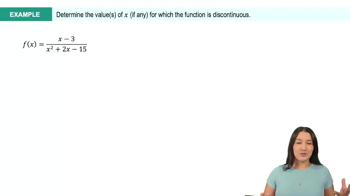Define g(4) in a way that extends g(x) = (x² − 16)/(x² − 3x − 4) to be continuous at x = 4.
Table of contents
- 0. Functions7h 54m
- Introduction to Functions16m
- Piecewise Functions10m
- Properties of Functions9m
- Common Functions1h 8m
- Transformations5m
- Combining Functions27m
- Exponent rules32m
- Exponential Functions28m
- Logarithmic Functions24m
- Properties of Logarithms36m
- Exponential & Logarithmic Equations35m
- Introduction to Trigonometric Functions38m
- Graphs of Trigonometric Functions44m
- Trigonometric Identities47m
- Inverse Trigonometric Functions48m
- 1. Limits and Continuity2h 2m
- 2. Intro to Derivatives1h 33m
- 3. Techniques of Differentiation3h 18m
- 4. Applications of Derivatives2h 38m
- 5. Graphical Applications of Derivatives6h 2m
- 6. Derivatives of Inverse, Exponential, & Logarithmic Functions2h 37m
- 7. Antiderivatives & Indefinite Integrals1h 26m
- 8. Definite Integrals4h 44m
- 9. Graphical Applications of Integrals2h 27m
- 10. Physics Applications of Integrals 3h 16m
- 11. Integrals of Inverse, Exponential, & Logarithmic Functions2h 31m
- 12. Techniques of Integration7h 41m
- 13. Intro to Differential Equations2h 55m
- 14. Sequences & Series5h 36m
- 15. Power Series2h 19m
- 16. Parametric Equations & Polar Coordinates7h 58m
1. Limits and Continuity
Continuity
Problem 2.5.57
Textbook Question
Removable discontinuity Give an example of a function f (x) that is continuous for all values of x except x = 2, where it has a removable discontinuity. Explain how you know that f is discontinuous at x = 2, and how you know the discontinuity is removable.
 Verified step by step guidance
Verified step by step guidance1
Step 1: Consider the function f(x) = (x^2 - 4)/(x - 2). This function is defined for all x except x = 2, because at x = 2, the denominator becomes zero, which makes the function undefined.
Step 2: To determine if the discontinuity at x = 2 is removable, factor the numerator x^2 - 4. Notice that x^2 - 4 can be factored as (x - 2)(x + 2).
Step 3: Rewrite the function f(x) as f(x) = ((x - 2)(x + 2))/(x - 2). For all x ≠ 2, the (x - 2) terms in the numerator and denominator cancel out, simplifying the function to f(x) = x + 2.
Step 4: The simplified function f(x) = x + 2 is continuous for all x, including x = 2. However, the original function f(x) = (x^2 - 4)/(x - 2) is undefined at x = 2, indicating a discontinuity.
Step 5: Since the discontinuity at x = 2 can be 'removed' by redefining the function to be f(x) = x + 2 for all x, including x = 2, we conclude that the discontinuity is removable. The limit of f(x) as x approaches 2 exists and equals 4, which matches the value of the simplified function at x = 2.
 Verified video answer for a similar problem:
Verified video answer for a similar problem:This video solution was recommended by our tutors as helpful for the problem above
Video duration:
3mPlay a video:
Was this helpful?
Key Concepts
Here are the essential concepts you must grasp in order to answer the question correctly.
Removable Discontinuity
A removable discontinuity occurs at a point in a function where the function is not defined or does not match the limit at that point, but can be 'fixed' by redefining the function at that point. For example, the function f(x) = (x^2 - 4)/(x - 2) has a removable discontinuity at x = 2 because it simplifies to f(x) = x + 2 for all x except x = 2.
Recommended video:

Determine Continuity Algebraically Example 3
Continuity
A function is continuous at a point if the limit of the function as it approaches that point equals the function's value at that point. For a function to be continuous at x = 2, it must be defined at that point, and the limit as x approaches 2 must exist and equal the function's value at x = 2.
Recommended video:

Intro to Continuity
Limit
The limit of a function describes the value that the function approaches as the input approaches a certain point. In the context of removable discontinuities, if the limit of f(x) as x approaches 2 exists and is equal to a specific value, but f(2) is not defined or does not equal that value, then the discontinuity is removable by defining f(2) to be that limit.
Recommended video:

One-Sided Limits
Related Videos
Related Practice
Textbook Question


